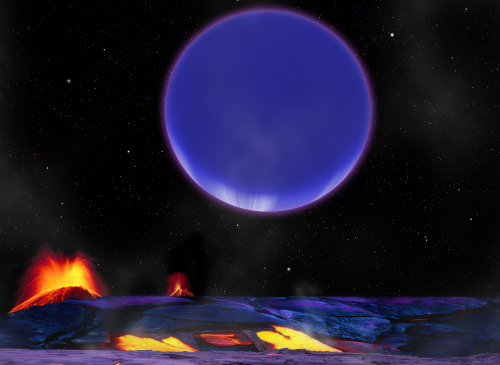
It’s raining life: could two nearby planets exchange living organisms? An artist’s impression of one planet in the Kepler 36 system as seen by its neighbour.
(Courtesy: Harvard-Smithsonian Center for Astrophysics/David Aguilar)
By Hamish Johnston and James Dacey
There is an intriguing article about alien life this week in The Conversation. “Twin civilizations? How life on an exoplanet could spread to its neighbour” is by David Rothery of the Open University and is a popular account of a paper that will soon be published in the Astrophysical Journal. The paper is inspired by the star Kepler 36, which has two planets that are in very close proximity to each other. While the Kepler 36 worlds are not suitable for life, the paper’s authors – Jason Steffen and Gongjie Li – explore possible exchanges of life between two Earth-like planets in similarly close orbits. Rothery explains that debris flung off one of the planets would stand a good chance of finding its way to the surface of the other planet after a relatively brief journey through space.
Could this lead to the evolution of parallel civilizations on the planets? Rothery argues that the chance of that happening is very small. But the universe is a big place and we are beginning to learn that stars with multi-planet systems are very common indeed. So I would be willing to wager that there are twin civilizations out there somewhere.
Liquid water is likely to feature on any planet that harbours life and the bizarre properties of this seemingly mundane molecule have probably challenged great minds throughout the universe. Back here on Earth, science writer Alok Jha has written a juicy volume called The Water Book: the Extraordinary Story of Our Most Ordinary Substance that looks at some of the big issues surrounding water – such as its role in climate change – and also puts H2O under the microscope to reveal its extrodinary chemical properties.
Jha’s book is one of 10 tomes that are shortlisted for Physics World Book of the Year, which will be announced on Tuesday 15 December.
There is a fantastic article this week in the Sydney Morning Herald about the physicist Paul Davies and his mission to change how cancer research is done. Written by Marcus Strom, the article was inspired by a talk given today by Davies at the University of Sydney in which Davies asks “Maybe progress [in reducing cancer mortality] is so slow because we are thinking about the problem the wrong way?”
Strom’s article begins “It takes a lot of front to tell an entire scientific discipline it’s barking up the wrong trillion-dollar research tree,” and includes a robust and critical discussion of Davies’s idea that cancer is an ancient genetic programme present within us all. To get the full story from Davies, check out this article he wrote for us in 2013: “Exposing cancer’s deep evolutionary roots”.
James Clerk Maxwell is a household name. That is, if your household contains a physicist, who may even own one of those geek-chic T-shirts with Maxwell’s equations printed on the front. To the outside world, however, Maxwell is largely unknown and certainly not an A-lister alongside the likes of Newton, Faraday and Einstein. Even this year, Maxwell had the misfortune of the 150-year anniversary of his equations of light being somewhat overshadowed by the 100-year anniversary of Einstein’s general theory of relativity.
In an attempt to put right this long-standing under-appreciation, the BBC has just created this information portal about the life and work of “Scotland’s forgotten Einstein”. It includes a timeline of Maxwell’s most significant achievements, including his prediction that Saturn’s rings are made from orbiting particles, and his colour triangle – a forerunner of the RGB model used in modern computing. You can also take a virtual tour of Maxwell’s house or watch clips from a documentary presented by Scottish earth scientist and science communicator Iain Stewart.
One is forced to say again and again that the Maxwell’s EM-equations are physics’s most fundamental equations as they form the basis of the most of the theories of modern physics such the Einstein’s STR and GTR and the partcles Standard Model. However, sadly and in spite of a continuos reminding, the PW smugly flows with the “mode” of the time limited more and less to the same few chosen ones due to the rooted-in partisan reasons.